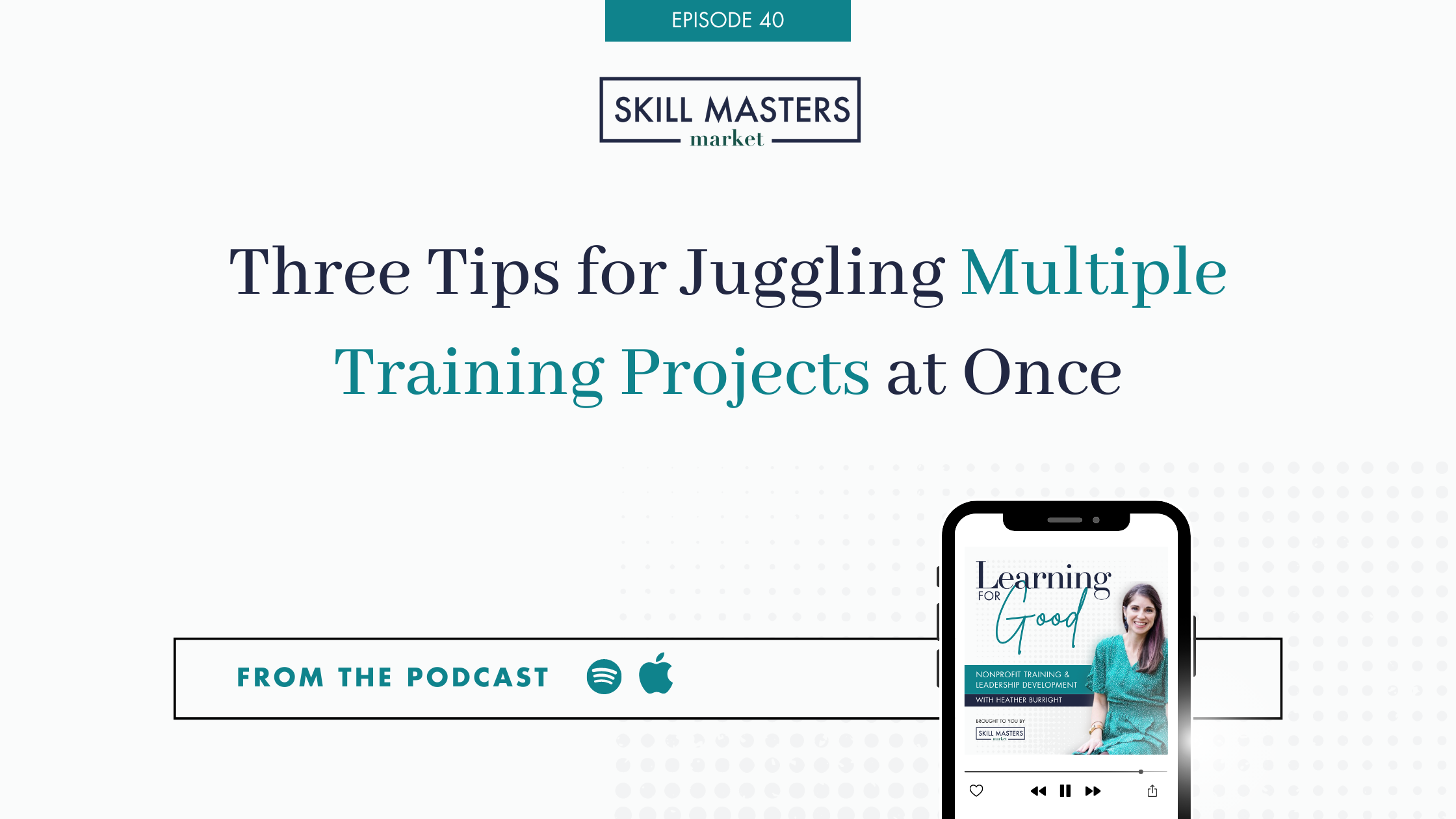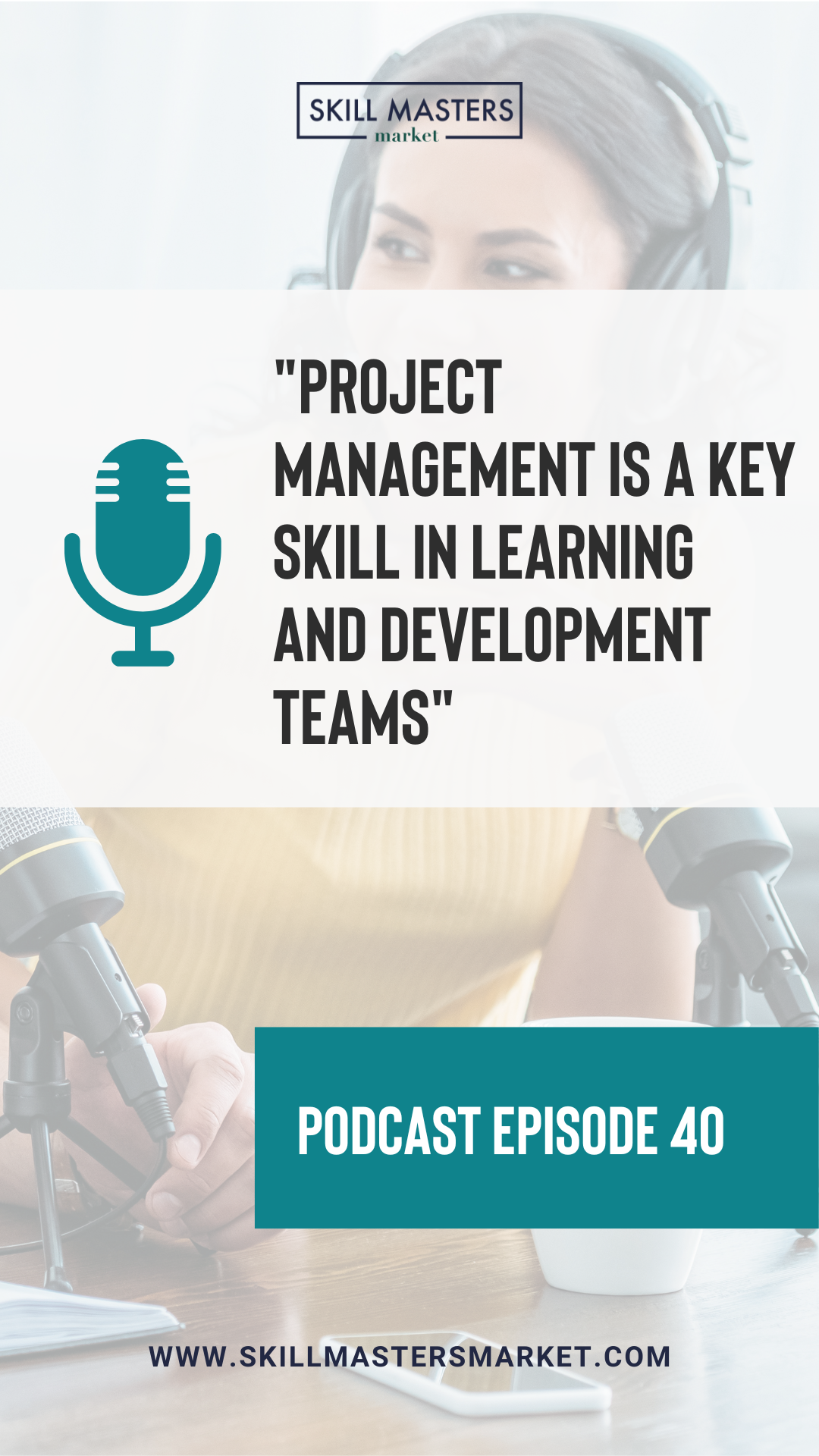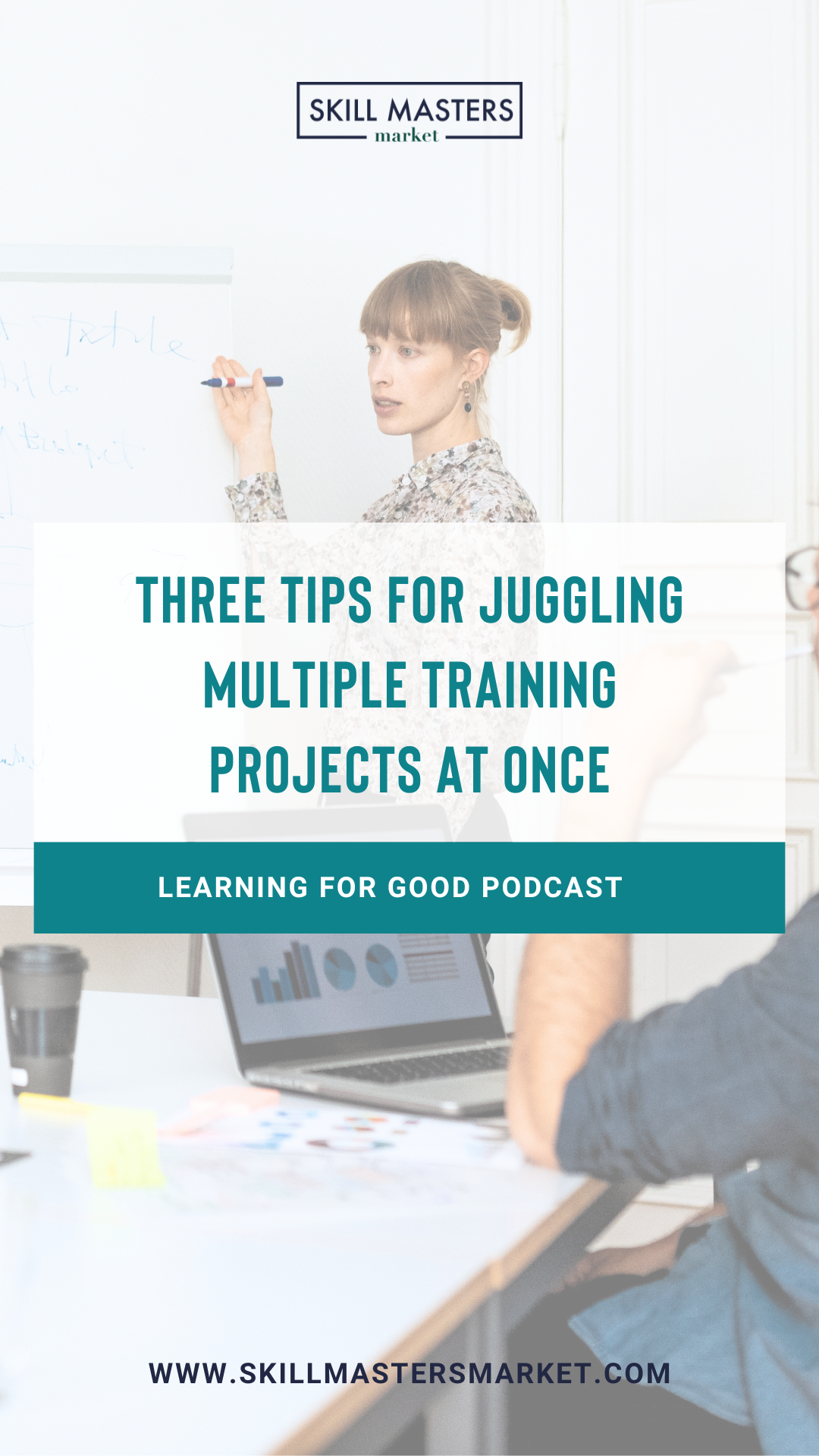Three Tips for Juggling Multiple Training Projects at Once with Jami Yazdani
I can remember when working internally at a national nonprofit, managing up to 10 projects at once.
They were in various stages of the process. They had different subject matter experts and different people approving the projects. They all had different modalities. And I had to keep up with all of them.
Project management is a key skill in Learning and Development teams.
So when Jami Yazdani and I connected about bringing you an episode on project management, I knew we had to get it scheduled. Jami is a pro at managing projects and she supports nonprofits all over the country. She is the perfect person to join us today to give us tips for juggling multiple projects at once.
Listen to the episode or scroll down to read the blog post ↓
Key Points:
02:17 An introduction to Jami Yazdani
06:21 Why it is important to manage projects well
09:31 The complexities of managing multiple projects at once
12:34 Three tips for nonprofit L&D leaders who are managing multiple training projects at one time
19:07 The importance of project retrospectives as part of your project plan
Click here to listen on Apple Podcasts. While you're there, subscribe to be the first to know about new episodes!
Three Tips for Juggling Multiple Training Projects at Once
I can remember when working internally at a national nonprofit, managing up to 10 projects at once.
They were all in various stages of the process, had different subject matter experts and different people approving the projects, and used different modalities. And I had to keep up with all of them.
Project management is a key skill in Learning and Development teams.
So when Jami Yazdani and I connected about bringing you an episode on project management, I knew we had to get it scheduled.
Jami is a pro at managing projects. She supports nonprofits all over the country and provides project management training. She is the perfect person to join us today to give us tips for juggling multiple projects at once.
In this blog post, we’re covering the following:
Three Tips for Nonprofit L&D Leaders Managing Multiple Projects at Once
Including Project Retrospectives as Part of Your Project Plan
Often as L&D leaders find ourselves in a position where we or our team members are managing multiple training projects at once. All with their own players, timelines, and modalities.
It is complex.
That’s why I'm excited for Jami to tell us everything we need to know about managing multiple training projects at once.
1) An Introduction to Jami Yazdani
Jami describes her career as a winding journey. Before she was a consultant, she had a career in libraries.
She started working at her university's library as a student, and then for about a year after graduation. She then moved into corporate roles in marketing and accounting departments but ultimately decided that librarianship was what she wanted to do as a career.
So Jami went back to school, got her Master of Library and Information Science degree from Louisiana State University, and started working in academic libraries.
Jami explains that she moved on really quickly and spent most of her career in management and leadership roles, including director roles.
“Because I was working in academia, I developed and delivered a lot of training. I was also involved in volunteer work with professional associations. And that's really where my passion for leadership and team development grew - being a supervisor and also working with these professional associations; I just love leadership and team development.” - Jami Yazdani
After more than 14 years in higher education and libraries, Jami turned her experience managing teams, projects, and change and her passion for leadership development into Yazdani Consulting and Facilitation where she helps mission-driven organizations lead more impactful projects, teams, and planning.
“I was going to focus on training and leadership development. But folks kept asking me to help them manage projects and planning, which I had done a lot of in my career. In my second Master's in Technology Management, I learned a lot about project management and change management. And so I did end up pivoting my business.” - Jami Yazdani
Jami is a certified Project Management Professional and disciplined, agile scrum master with more than 16 years of experience managing a portfolio of innovative projects and planning initiatives. Jami also has extensive experience designing and delivering engaging face-to-face and online training sessions and facilitating meetings and programs.
Jami has actively served on boards of several nonprofits and professional associations working in leadership, marketing, programming, and mentoring functions.
2) Why it is Important to Manage Projects
Before we get into how to manage projects, why is it actually important to manage projects? Why should we care?
Jami explains that projects are the way organizations are structuring their work these days.
“Instead of just thinking about continuing operations, we really are thinking about project work. So project management supports us in more collaborative work and helps us get people and resources together to achieve goals and objectives.” - Jami Yazdani
Jami highlights that if we think it's important to manage our work, our teams, and our relationships well, then it's going to be important to make sure that we're managing our projects well.
“Sometimes folks don't think of their work, their collaboration, their effort, their initiative, and their training that they're building as a project. So they often don't think project management strategies are going to be relevant to them.” - Jami Yazdani
When Jami does project management training, she always makes sure to point out how broad the definition of a project really is.
The Project Management Institute, which is the International Association for Project Managers, defines a project as a temporary endeavor undertaken to create a unique product, service, or result.
“So if we think about Learning and Development, a lot of what you might be calling a program, a training, an initiative, really is a project. You're working on it temporarily, and you're creating something unique. Whether it's unique to the world, which is awesome and wonderful. But more likely, it's unique to your organization, your client, and your team. And so I do think a lot of what folks are working on our projects. And so the tools of project management really do apply.” - Jami Yazdani
Particularly in Learning and Development work, where Jami highlights that you are trying to create buy-in and get collaboration and action from diverse groups of people. Project management strategies are actually built to work well outside of a hierarchy.
“It's built for collaboration when you don't have authority over people. Which is most Learning and Development work. You're building things for people who don't report to you. So the strategies apply.” - Jami Yazdani
So much of learning and development is collaborative. So to have a way that you can bring people together, engage them towards certain goals, keep everyone focused, and influence the team is really important.
3) The Complexities of Managing Multiple Projects at Once
Jami highlights the two key complexities she sees when people manage multiple projects at once - time management and prioritization.
“It’s one thing to learn how to manage one project well which often when people are going to project management training or reading about it, that's really what the focus is. But I think every project you add on to that adds a degree of difficulty to each of the projects that you're managing.” - Jami Yazdani
Most of us aren't just managing a project, we may also have other responsibilities that are ongoing Jami explains.
“So how do we manage our team's time well, but also our own time well, when we have all of these things that we're juggling? But also, how do you prioritize time when you have multiple projects pulling on you?” - Jami Yazdani
Jami thinks it's that prioritization, that's really challenging. Especially when you have project team members whose prioritization is different from yours.
“When you have multiple projects, and they're all asking you to do multiple things, and there's problems and you're putting out fires, how do you deal with that? So I think that's where the challenge really comes in.” - Jami Yazdani
4) Three Tips for Nonprofit L&D Leaders Managing Multiple Projects at Once
Jami shared some tips for managing multiple projects at once. These are all things she does herself, that you can implement right away.
1. Set concrete deadlines
One thing Jami often sees is leaders managing time for a project but neglecting to manage time for themself.
“It comes down to managing your own time well. And so often as a project manager, and whether you think about it as a project or not, you're thinking about how much time developing a training or a program is going to take. But you're often not thinking about your own time in project management. And so what I tell people first is to make sure that you're assigning concrete deadlines for project tasks.” - Jami Yazdani
According to Jami, this is something you should be doing even if you're just managing one project.
Another tip from Jami is to make sure the deadline is not vague. So instead of asking for something by the end of the week or before the next meeting, you should be asking for it by a specific date or time.
“I always say, concrete deadlines set concrete expectations. And so we want to set some concrete deadlines.” - Jami Yazdani
This is something Jami does for herself. When she’s building a training, she breaks it down into steps and sets a deadline for each step. She focuses on setting due dates for herself for project management tasks. This includes all the things that you need to do as a project manager to manage the project. This might be developing a project plan, getting an update, creating a progress report, or setting up the meeting agenda for your team meeting. All these tasks should be assigned to you and should have a due date.
”I often say that you want to project manage yourself. It's a little bit meta, you want a project manager [of] project management. But I think that's really the most important thing that you can do.” - Jami Yazdani
If sticking to deadlines is something you battle with when managing projects, then you might want to tune into Episode 37 of the podcast. I go over two ways to keep your projects on time.
2. Block time
Jami’s second tip is to block time to focus on each project.
“I often say that if you're only setting aside time for meetings and the tasks that you have to do for a project, and you're not setting aside time for project management tasks, you are going to get very, very overwhelmed. And so for many people, time blocking really can help.” - Jami Yazdani
Jami recommends setting aside 30 minutes to an hour each week, for each project. This time will allow you to see where the project stands, what needs to be done, and if people are meeting their deadlines.
“Setting aside that time can help us not get so overwhelmed and to really have a good understanding of where the project is. Which I often think is where people get overwhelmed. They don't know what's happening and they've got so many moving parts. And so setting that time to really focus on each project can help.” - Jami Yazdani
3. Creating efficiencies and using templates
The third tip from Jami is to create efficiencies.
‘If there are things that you are doing over and over again across your projects, and this could be either from a project management perspective, but also just from a learning and development perspective, if there are things that are similar across projects, create templates to do those things so that they're the same each time. That’s going to save you time” - Jami Yazdani
Jami has templates for reminder emails and reports for meeting agendas. These are things that she can very quickly update and it means that she’s not spending that much time on those types of project management tasks.
“If you are managing a lot of projects, it can be very helpful to take some time, step back and think, what am I doing across these three projects that are the same? Is there a way that I can create a template or do something for one of those projects that I can repeat for the others? And so I think the goal here is to not reinvent the wheel with each new project. Each new project may feel different, but in reality, a lot of it is going to be the same. And so a good place to start is those pieces that are project management tasks because often they're the same across projects.” - Jami Yazdani
I love these tips and they are all things that I do as well. As a training and leadership development consultant to nonprofits, I'm often managing multiple projects and team members. I use a project management template for each type of project that I work on. There are things that will be customized within that template once I start thinking through the project plan for each unique project. But I have a starting point that just makes a project more efficient.
5) Including Project Retrospectives as Part of Your Project Plan
One of the best strategies Jami has learned for managing projects is to do project retrospectives at the end of each project.
These can be really simple. According to Jami, all you need to do is ask three questions:
What went well?
What didn't go well?
What did we learn?
When something works well, Jami says those are the places where you can think about creating some efficiencies.
“You do need to make time for that. It should be part of your project plan. It should have a date assigned to it. You should do it pretty soon after the project ends. I know you're moving on to the next thing and you have other projects going on. But building that in is probably one of the best ways to look back and see what's working for you.” - Jami Yazdani
If you’re looking for somewhere to start, I wrote a blog post on three ways to incorporate reflection in your training.
As L&D professionals, a lot of times we will include reflection in training, but to also include it in a project for ourselves is a great tip.
Are you managing multiple projects? What are some other ways you've been successful in managing multiple projects at one time? Head on over to the Nonprofit Learning and Development Collective to share your tips with a diverse network of L&D, talent management, and DEI Leaders.
To hear the full conversation I had with Jami Yazdani on the Learning for Good Podcast, scroll all the way up and tune into episode 40.
The Nonprofit Learning and Development Collective
Do you wish you could connect with other nonprofit learning and development leaders?
I know what it feels like to want someone to bounce ideas off of and to learn from, someone who really understands you and your work. Imagine if you could have a simple way to meet people in the field, ask questions, and share information.
That's why I created the Nonprofit Learning and Development Collective – so nonprofit L&D, talent management, and DEI leaders can connect with each other quickly and easily in a virtual space.
When you join this community, you will walk away with a new, diverse, and powerful network – and a sounding board for your staff development needs.
So if you're ready to exchange ideas and collaborate with your peers, come join the Nonprofit L&D Collective.




